Let's take a closer look at the Egyptian New Empire period [EN - FR].
Hello dear fellow travelers and Hivers, I hope you are well :)
Here we are back at the Louvre museum for the second part of this visit in the Egyptian antiquities department, to attack this time the overview of this period closer to us in time... even if we are still several dozens of centuries away !
For a more comprehensive and surely relevant overview, I recommend you to have a look at the first episode of this visit. This will allow you to see the evolution of the objects, the technologies used for their realization and the greatest aesthetic finesse for some of them. For the detail of my photographic equipment, I am always accompanied by my Nikon D5500 and a 17-70mm "all purpose" lens from Sigma, with which I am very satisfied since my purchase.
But let's go for a walk today, between scribes, gods with animal heads and other mysterious artefacts...!
The New Empire is the period from approximately 1500 BC to 1000 BC. This period is known to have been one of the most prosperous of all Egyptian history after the golden age of the Old Kingdom. This period of refinements and evolutions, which lasted for a little more than five centuries, included many illustrious figures such as Thutmes, Hatshepsut, Akhenaten, Tutankhamun and the Ramses lineage...
Above, a king represented as a scribe, a prestigious function since it is the class of writers and accountants, in any case those who interact with writing, a sacred and magical domain for the ancient Egyptians.
That's a bit of a backdrop to the back-to-back rooms that make up the Egyptian antiquities department. I am not ashamed to say it, but it is an environment in which it is sometimes easier for me to evolve and feel myself than in a crowded street or the aisle of a shopping centre full of colors and noise...
As I love collections, often of the same object, how could I not be sensitive to this gathering of tiny vases all cut in alabaster, this rock that lets the light pass through its structure and gives a rendering so all to the material ?
Animal representations or those inspired by the natural world continue to be omnipresent, as can be seen in this hippopotamus and this bowl with fish motifs and blue glazes. One senses a great observation of the natural world and therefore an equivalent proximity.
It is like those scarabs, amulets that almost everyone has as a representative image of ancient Egypt. Sometimes it is the dung beetle that is represented as a symbol of the one who rolls the sun as the insect rolls its ball of concretions.
Here we return to more everyday objects with these double vases and pierced, almost glazed gourds, which inspire and please me greatly.
Other objects that I like very much are these little spoons for blushes that represent swimmers with long bodies and who are carrying a duck. I like this alliance between the usual and the decorative, the aesthetic.
Other objects related to the intimate sphere and which are in fact all vases. The one that looks like a pomegranate, the ibex, and the woman and child, which is somewhat reminiscent of pre-Columbian pottery.
Here, a fragment of a statue whose enamel pleases me a lot. Not to mention the finesse of the representation of a king and a queen. But of the king... Well, only the arm remains !
I also really like the fragments, the remains that leave room for the imagination and the work of the brain to fill in the gaps and put the statues back together.
Other objects of everyday life. A small blue bead in the shape of a delicate flower, an antelope spoon and again seals with the cartouche of famous kings. I say again because in the first episode there were a lot of these different systems to mark materials with their name, especially raw clay.
At the bend of the 543rd window ^^, while raising my head, I meet the mineral gaze of Akhenaten, the pharaoh considered as a heretic at his death for having wanted to change during his reign the cult of Amun, one of the primordial gods, for that of Aten, a form of the sun.
His son, the famous Tutankhamun, re-established the old cult, but died in his early years and did not have time to follow its effects. Then will come the line of Ramses, but that is another story...
But to come back briefly to Akhenaten (or Amenhotep IV which was his original name), is also known to have impelled the "Amarna art", a style of representation which breaks with the tradition and the canons previously in force. It is an almost naturalistic art with an abundance of flowers, plants and birds, and is characterised by a very strong idealisation - which gives its features so stretched that we can see in the sculpture in particular.
In the room that ends the Egyptian department and transforms almost seamlessly into the Latin and Etruscan arts, one comes face to face with these two religious sign bearers. One represents a ram, the other a falcon, the sacred symbol of the god Horus, the son of the god of the dead (and of Life), Osiris, who is hardly ever introduced.

We find it here in the centre of this richly and magnificently worked pendant which bears the name of King Osorkon II of the 22nd dynasty, it's made of gold, lapis lazuli and red glass. In the centre is Osiris, surrounded by his wife Isis and his son Horus.
Two lights and two atmospheres for different renderings of the gold shine.
We can feel here that the finesse of the objects has continued to progress with this other pendant with a lioness head or this very fine ring decorated with three miniature ducks.
The various latest sculptures we see allow us to appreciate the evolution of the arts and their ever increasing refinement.
Here, a flat display case full of amulets, each more beautiful and finely crafted than the las t! For those in the know, one can recognize the god Bes, a household genie who is supposed to be so ugly and repulsive that he scares away even demons that might want to enter the home.
A polychrome funerary stele painted on wood which also shows the changes of support...
We could have finished with this other representation of the god Bes which is quite incredible with the prominent erection of the character - observe carefully his knees ^^ !
But I still preferred to end this personal journey through the ages and periods of Egypt with the figure of a pharaoh whose look is, let's say... so concentrated ! This fast pace of the visit would almost make you dizzy if you thought about it. I hope you have enjoyed this visit and I thank you for your time with us, even on the other side of our respective screens !
I wish you a very nice day, take good care of yourself and your loved ones. See you soon,
<3
Obviously not an gram of AI in all this.
All these images are mine, please bear that in mind.
Bonjours chers amis de Hive, j'espère que vous allez bien :)
Nous voilà de retour au Louvre pour la seconde partie de cette visite dans le département des antiquités égyptiennes, pour cette fois attaquer le tour d'horizon de cette période plus proche de nous dans le temps... même si on reste encore et toujours distants de plusieurs dizaines de siècles !
Pour avoir une vision d'ensemble plus globale et sûrement pertinente, je vous recommande d'aller jeter un oeil au premier épisode de cette visite. Cela vous permettra notamment de voir l'évolution des objets, les technologies mises en oeuvre pour leurs réalisations et la plus grandes finesses esthétiques pour certains d'entre eux. Pour le détail de mon matériel photo, je suis toujours accompagné de mon Nikon D5500 et d'un objectif "à tout faire" 17-70mm de chez Sigma et dont je suis très satisfait depuis mon achat.
Mais lançons-nous dans la balade de cette journée, entre scribes, dieux à têtes d'animaux et autres artefacts mystérieux..!
Le Nouvel Empire est cette période qui va approximativement de -1500 à -1000 avant notre ère. Cette période est connue pour avoir été l'une des plus prospère de toute l'histoire égyptienne après l'âge d'or de Ancien Empire. Cette période de raffinements et d'évolutions qui s'étale donc sur un peu plus de cinq siècles et compte de nombreux personnages illustres parmi lesquels: Thoutmôsis, Hatchepsout, Akhenaton, Toutânkhamon et la lignée des Ramsès...
Ci dessus, un roi représenté en scribe, une fonction prestigieuse puisqu'il s'agit de la classe des écrivains et des comptables, en tout cas ceux qui interagissent avec l'écriture, domaine sacré et magique chez les anciens égyptiens.
Voilà un peu le décor de ces salles qui s'enchaînent et constituent le département des antiquités égyptiennes. Je n'ai pas honte de le dire, mais c'est un environnement dans lequel il m'est parfois plus facile d'évoluer et de me sentir moi-même que dans une rue populeuse ou l'allée d'un centre commercial plein de couleurs et de bruits...
Comme j'adore les collections, souvent d'un même objet, comment ne pourrais-je pas être sensible à ce rassemblement de minuscules vases tous taillés dans l'albâtre, cette roche qui laisse passer la lumière à travers sa structure et donne un rendu si tout à la matière ?
Les représentations animales ou inspirées du monde naturel continuent d'être omniprésentes et on peut le constater avec cet hippopotame et ce bol aux motifs de poissons avec leurs émaux bleus. On sent une grande observation du monde naturel et donc une proximité équivalente.
C'est comme pour ces scarabées, amulettes dont tout le monde ou presque a comme image représentative de l'Égypte Ancienne. Parfois c'est le bousier qui est représenté comme symbole de celui qui roule le soleil comme l'insecte roule sa boule de concrétions.
On retourne ici dans des objets plus usuels avec ces vases doubles et ces gourdes percées, presque vernissées et qui m'inspirent et me plaisent beaucoup.
D'autres objets que j'aime beaucoup, ce sont ces petites cuillères à fard qui représentent des nageuses aux corps longilignes et qui porte un canard. J'aime cette alliance entre l'usuel et le décoratif, l'esthétique.
D'autres objets liés à la sphère intime et qui sont en fait tous des vases. Celui qui ressemble à une grenade, le bouquetin et la femme et l'enfant qui fait un peu penser à une céramique pré-colombienne.
Ici, un fragment de statue dont l'émail me plaît beaucoup. C'est sans parler de la finesse de la représentation d'un roi et d'une reine. Mais du roi... Eh bien il ne reste que le bras !
J'aime aussi beaucoup les fragments, ces restes qui laissent de la place à l'imagination et au travail du cerveau pour combler les manques et recoller les statues.
D'autres objets de la vie de tous les jours. Une petite perle bleue en forme de fleur si délicate, une cuillère antilope et de nouveau des sceaux avec le cartouche des rois fameux. Je dis de nouveau car dans le premier épisode, il y avait un grand nombre de ces différents systèmes pour marquer de son nom des matière, et notamment l'argile crue.
Au détour de la 543ème vitrine, en levant la tête, je croise le regard minéral d'Akhenaton, le pharaon considéré comme un hérétique à sa mort pour avoir voulu changer durant son règne le culte d'Amon, un des dieux primordiaux, pour celui d'Aton, une forme du soleil.
Son fils, le célèbre Toutânkhamon rétablira l'ancien culte, mais mort dans ces jeunes années, il n'aura pas eu le temps d'en suivre les effets. Alors adviendra la lignée des Ramsès, mais cela, c'est une autre histoire...
Mais pour en revenir brièvement à Akhenaton (ou Amenhotep IV qui était son nom à l'origine), est aussi connu pour avoir impulsé "l'art amarnien" ce style de représentation qui rompt avec la tradition et les canons précédemment en vigueur. C'est un art presque naturaliste où abonde les fleurs, les plantes et les oiseaux et qui se caractérise par une très forte idéalisation - ce qui donne ses traits si étirés que l'on peut constater dans la sculpture en particulier.
Dans la pièce qui termine le département égyptien et se transforme presque sans transitions vers les arts latins et étrusques, on tombe dès l'entrée nez à nez avec ces deux porteurs d'enseignes religieuses. L'une représentant un bélier l'autre un faucon, symbole sacré du dieu Horus, le fils du dieu des morts (et de la Vie), Osiris que l'on ne présente presque plus.

On le retrouve justement ici au centre de ce pendentif richement et magnifiquement ouvragé qui porte le nom du roi Osorkon II de la 22ème dynastie et qui est réalisé en en or, lapis-lazuli et verre rouge. AU centre se trouve Osiris donc, entouré de sa femme Isis et de son fils Horus.
Deux lumières et deux ambiances donc pour des rendus des brillances de l'or notamment différentes.
On sent ici que la finesse des objets n'a cessée de progresser avec cet autre pendentif à tête de lionne ou cette bague très fine ornée de trois canards miniatures.
Les différentes dernières sculptures que nous voyons nous laissent en effet apprécier l'évolution des arts et leur raffinement toujours plus poussé.
Ici, une vitrine plate pleine d'amulettes toutes plus belles et finement réalisées les unes que les autres ! pOur les connaisseurs, on reconnait le dieu Bès, un génie du foyer censé être si laid et repoussant qu'il fait fuir même les démons qui pourraient vouloir s'introduire dans les habitations.
Un stèle funéraire polychrome peinte sur du bois ce qui montre aussi les changements de support...
Nous aurions pu terminé avec cette autre représentation du dieu Bès qui est assez incroyable avec l'érection proéminente du personnage - observez attentivement ses genoux ^^ !
Mais j'ai tout de même préféré terminer cette traversée personnelle des âges et des périodes égyptiennes par cette figure d'un pharaon assez comique par son regard, disons... si concentré ! Cette allure de visite si rapide nous donnerait presque le tournis si on y pensait bien. J'espère que cette visite vous aura plût et je vous remercie pour votre temps en notre compagnie, même de l'autre côté de nos écrans respectifs !
Prenez bien soin de vous et de vos proches, je vous souhaite une très belle journée. À très bientôt,
<3
Évidemment pas un gramme d'AI dans tout ceci.
Toutes ces images sont les miennes, merci d'en tenir compte.





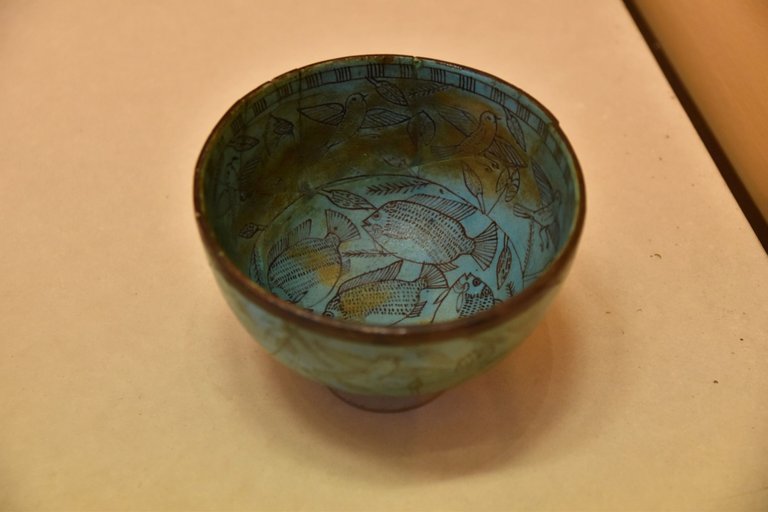


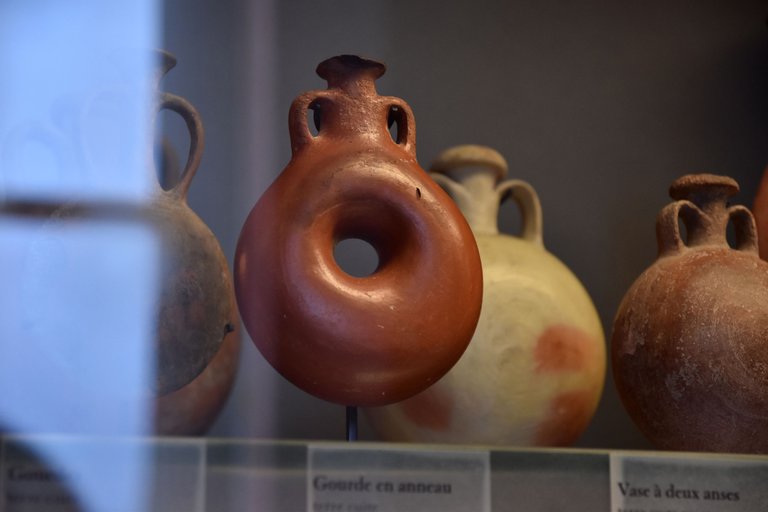

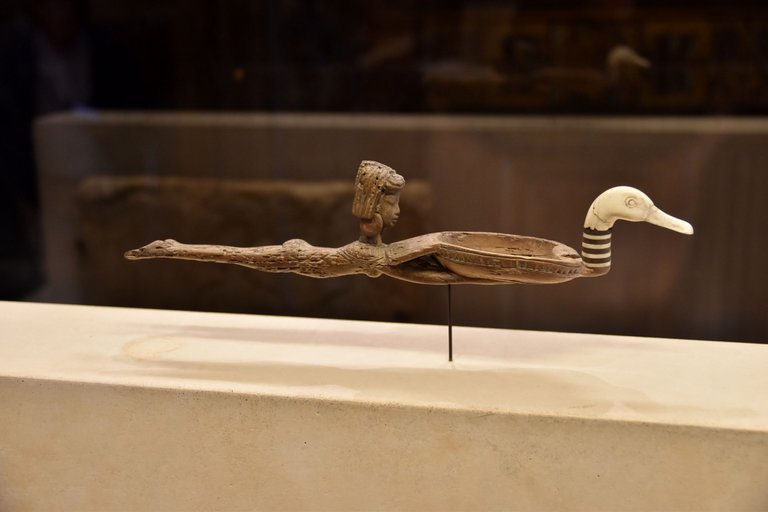

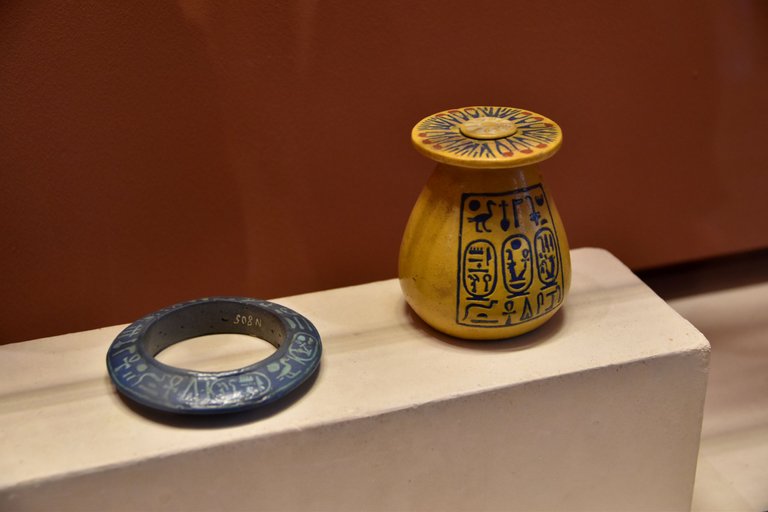


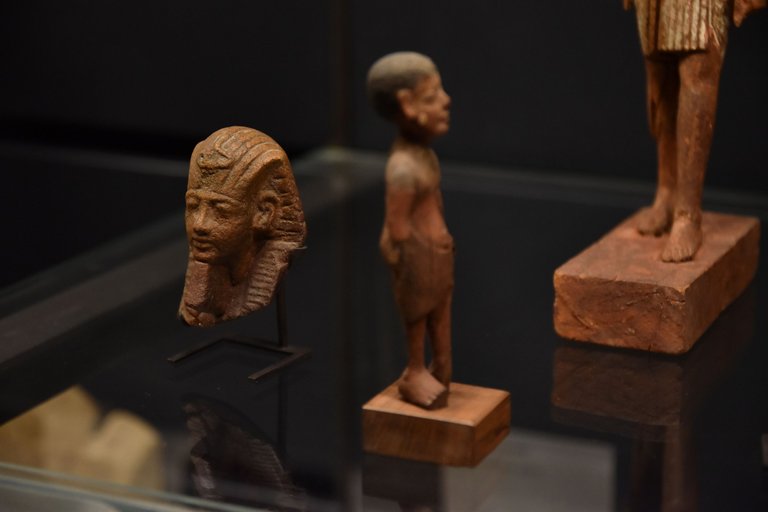









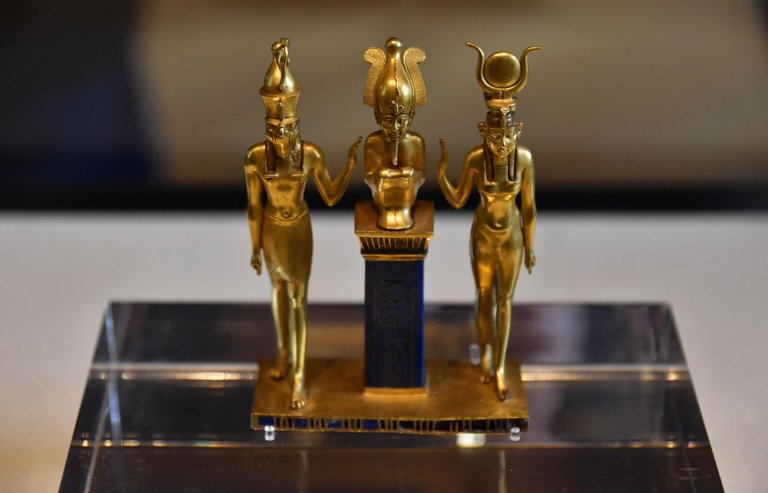


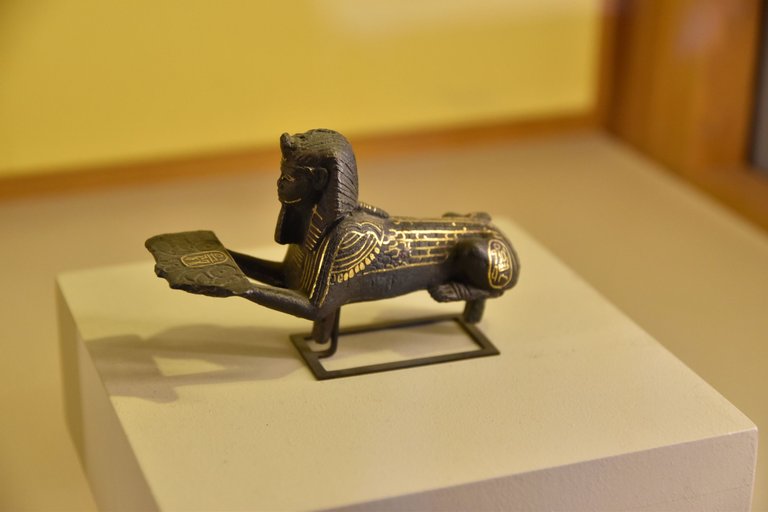


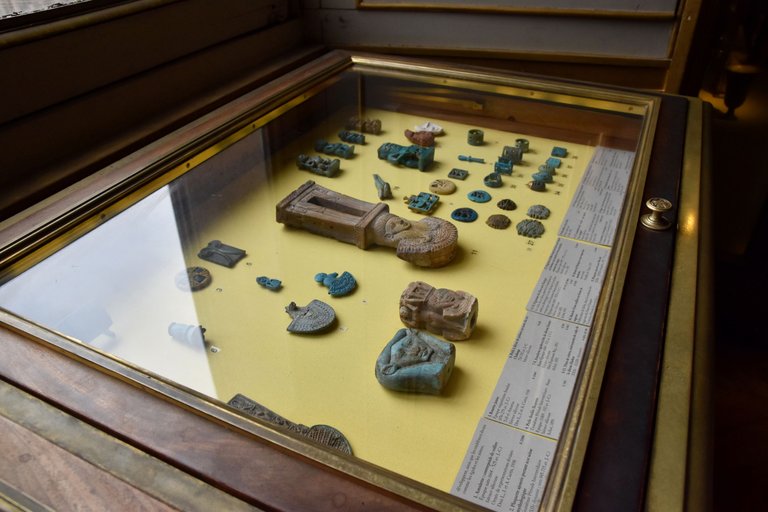




Wow, it is superb!! I have never seen this before, I love to see such type of antique things. They are precious.
Glad you enjoyed this visit !
Thanks ✌️
Congratulations, your post has been added to Pinmapple! 🎉🥳🍍
Did you know you have your own profile map?
And every post has their own map too!
Want to have your post on the map too?
So many interesting artifacts I would love exploring there thanks for sharing it with us
Thanks for joining the Wednesday Walk, its my pleasure to host it and see all the posts each week from all around the world, including yours, if you have time visit some of the other walks this week there are so many interesting ones
This part was way richer I think and it was nice to appreciate that through time and centuries !
Thanks for visiting with us, I wish you a good day 😊
thanks and wishing you a good day also
Thanks 😇 !
So many very interesting artifacts. I love historic places and of course museums that show cases them. I enjoyed the tour thanks for sharing.
Hey @coolmidwestguy, I'm glad you enjoyed this visit !
Those places are also among my favorite, so much to see and to learn 😇
Take good care !
Hiya, @ybanezkim26 here, just swinging by to let you know that this post made it into our Honorable Mentions in Daily Travel Digest #1854.
Your post has been manually curated by the @pinmapple team. If you like what we're doing, please drop by to check out all the rest of today's great posts and consider supporting other authors like yourself and us so we can keep the project going!
Become part of our travel community:
Thanks dear @ybanezkim26 !
I hope you're doing good, take good care of you 😇
You're welcome! I'm doing great! Thank you!
Good :D
Enjoy your weekend ✌️
Great Post, Upvoted 100% with HP delegated from Hive Birthday event
Thanks for Sharing
Thanks dear @queen-silvia ! I'm happy you enjoyed and appreciate your support, have a great day 😉
I did not have time to comment on this today, but, before I forget, I just wanted you to know what a fabulous post it is, a detailed depiction of everything they do. It is always amazing that their art covers an extended period of time, yet, has changed little.
Well done.
Hehe, that's even more appreciated if you didn't have so much time ! I'm truly grateful for your visit and happy if you enjoyed it 😊
Yes, there's a true consistency in their works, and perfect balance of changes and evolutions on the same timeline(s), like the tree of technology in fact :D
I wish you a good day dear @dswigle, I hope you're doing well 😇
Balance. It works for almost everything in life.
The weekend will be upon us when you wake!
Have a fabulous Friday!
Yep, this and the theory of reciprocity... Now it's almost the only thing that guid me in life. Treating others, people and all things, like if they were me... Which they're in reality, as I'm them in the same universe :)
Thank you !
Let's have a balanced and philosophical Friday and weekend haha,
sending you best 😇
I've always admired the Egyptians for their attention to detail and I love those alabaster vases and the scarabs. I'd never seen the spoons with the ducks and ladies lying down before, they are wonderful. So many beautiful pieces and rich with history, I would love to see that collection in person one day.
Like many children, I think I was fascinated by the history of the Egyptians. At one point I wanted to be an archaeologist, but it's hard to choose one thing over another... For me too it was a real discovery, even if I visited a lot of museums and exhibitions about the ancient Egyptians, the spoons with the women and the ducks, that and others, it was totally new for me...!
I'm glad you enjoyed the visit, thanks again. Have a nice day and see you around soon 😉 !
Very nice photos and post anttn thanks for sharing.🙏😊
Thank you dear @hindavi ! I'm happy you enjoyed that tour with us 😊
How is going with the heat in India ? I hope you're well and that is better than the last time we talked 🤞
Take care 😘
Love the closeups taken of the artifacts and all the little pieces that most likely very few notice in the showcases. Not for a few times I went to museums or all kinds of exhibitions with lots of interesting things exposed but didn't notice all their small details, so I feel like your post made my brain richer in history than any other place explored before :)
Yes, exactly ! It takes a lot of time to look and see things ! To tell you the truth, I was quite tired at the end of the tour, also because we had visited other aisles and departments of the museum...
That's the best compliment you could give me ^^ !
Thanks again, I wish you a very nice day 🤞
Thank you! Hope you have a lovely day too! The appreciation is real :)
Thank you !
May you have a nice weekend ahead as well 🤞🌱
merci beaucoup encore @anttn nice work. Best+!
Toujours un plaisir :D
Bon weekend en perspective à toi !
https://leofinance.io/threads/@thetimetravelerz/re-leothreads-2ulxx47cv
The rewards earned on this comment will go directly to the people ( thetimetravelerz ) sharing the post on LeoThreads,LikeTu,dBuzz.
Hola, excelente post, gracias por compartir me ha encantado las fotos con cada figura ancestrales,
Hey there @fotomaglys 👋
Thanks for visiting, I'm glad you enjoyed the tour !
Have a good day 😇🌱